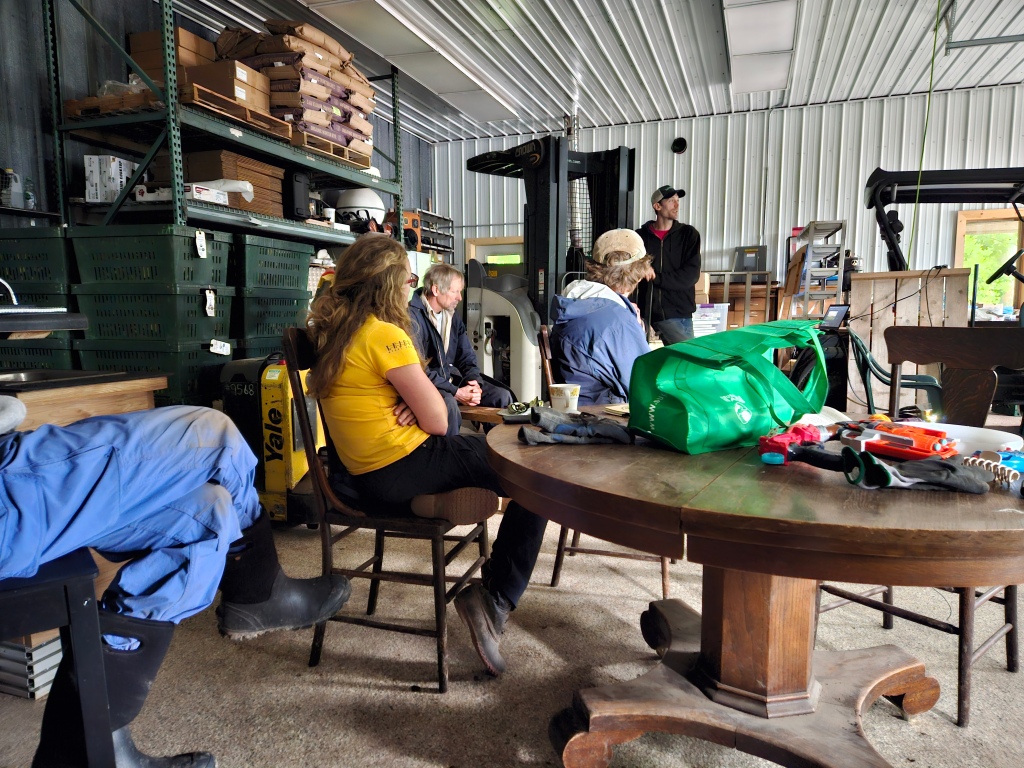This week was filled with more rain. If any of you know Mother Nature personally, will you please let her know that we are good on rain, and could really use some sunshine. We would especially like to see some sun now that we’ve reached the official start of Summer! I’ve always been told that the Summer Solstice is the longest day of the year to allow us more time to find joy in the constant change that is happening around us.
One of the big, and exciting changes that happened on the farm last week was the debut of the new chopper box (also known as a forage wagon). Thanks to all of your support, the farm was able to purchase a new to us, chopper box earlier this Spring.

Every fall, after harvest, we plant a cover crop of rye. The rye goes dormant over the winter, and starts to grow again in the Spring. While it’s growing, it’s adding fertility to the soil, supporting soil life, suppressing weeds, and preventing soil erosion from happening (something we are really thankful for this year). Right before the rye goes to seed, we cut the rye, and it’s blown through a chute into the chopper box. An auger inside the box then pushes it out onto Janaki’s handmade ramp, and drops it in the aisleways between the onion beds. The crew then smooths it out to make sure it will be effective. This is what we spent most of last week doing. In the coming weeks, we will spread mulch around the outdoor tomatoes once they’ve dried off a bit.
The rye mulch serves multiple purposes for different crops. For the onions, we mainly use it to suppress weeds. Less weeds means less use of the tractors for cultivation, and less labor needed to weed by hand in the places the tractor can’t access. It also creates earthworm habitat and food, leaving the field healthier than before the season. For the tomatoes, we use the mulch as a weed suppression, disease prevention, and as a way to retain moisture. Tomatoes appreciate a warm environment which leads to faster water evaporation. The mulch slows that evaporation which lessens the frequency at which we need to water, and prevents soil from splashing onto leaves.
To me, one of the coolest parts of the mulch is that we don’t remove it once the vegetables are harvested. We leave all of the mulch exactly where it is, and Farmer Janaki tills it into the soil before he plants another cover crop in that field. This adds organic matter which improves the health of the soil, and provides a habitat for organisms. Some of those organisms will prevent diseases, and help to control the levels of pests.
The farm crew was able to learn all this information about cover crops during what we called “classroom time”, a few weeks ago. This was an unusual occurrence considering we are normally too busy with field work to all come together for an educational session, but when the fields are too wet to work, we finally have time to talk about the behind the scenes of farming. This is just another one of the many ways the farm crew is embracing the changes being thrown at us thanks to mother nature and her abundance of rain. Fingers (and toes and arms and legs) crossed this week stays a little drier, so our outdoor vegetables can get some much needed love and attention.

In your share this week:
Broccoli – Lettuce – Spinach – Green Onions – Pac Choi
If you’re looking for some non-salad ways to use up greens, Deb has a few more ideas for you!
Cannellini Beans and Wilted Greens
2 cans cannellini beans
1 large bunch spinach, pac choi, or mixed greens (appx 1/2 lb)
1-2 cloves garlic
1/4 cup olive oil
1.5 tsp rosemary, chopped
Wash and prepare greens. Drain beans and reserve liquid. Finely chop garlic and sauté in olive oil with the rosemary for 1 minute. Add the beans and 3/4 cup bean liquid and simmer for 5 minutes, until some of the beans have fallen apart. Add the greens to the beans and stew until they are wilted and tender. Add more liquid if needed. Salt and pepper to taste.
Serve as a side-dish with olive oil drizzled over the surface
Lentils with Greens and Ginger
1 cup green lentils, rinsed
2 1/2 cups water
1-2 hot green chilies, finely sliced (optional!!)
1 tsp finely grated ginger
1/2 cup chopped cilantro
1-1/4 lbs spinach
1 tsp salt
Black pepper to taste
2 tbsp lemon juice
Cook lentils in water until soft. Put oil in large sauté pan (large enough to hold spinach) over medium heat. When hot, add chilis and ginger- stir and fry for 10 seconds. Add cilantro and spinach. Continuously stir and cook until spinach has wilted. Add cooked lentils (with any remaining cooking water)and salt. Stir to mix and bring to simmer. Cover and cook gently for 10 minutes- add pepper and lemon juice. Cook for 5 minutes. Serve with rice
For the farm crew,
Jennifer
